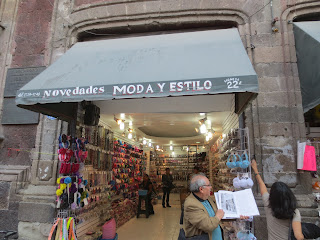|
Documentary
Monday, December 9, 2013
"Searching for Posada" Lecture at The Mexican Museum, San Francisco, CA December 14, 2013
Wednesday, November 6, 2013
Posada's Calaveras Visit San Jose, CA Winchester Mystery House
Posada's calaveras visited the Winchester Mystery House in San Jose, CA for their Dia de los Muertos observance. It was the first time for the Winchester to sponsor such an event. There was an altar and a variety of original images from the New World Prints Collection. Sarah Winchester might have found them disturbing as she believed that the spirits of the dead killed by the guns her husband created might come back to find her. Thanks to Posada's calavera images perhaps they did in some ways!
Monday, October 7, 2013
Thursday, September 26, 2013
Frida Kahlo and José Guadalupe Posada

Posada's art has influenced many artists over the years. One was Frida Kahlo. The images shown here in this blog posting show striking similarities. Here is a partial quote from an interview of Frida conducted back in 1933.
"I had gone up to the Barbizon-Plaza hotel to interview Frida Kahlo, who was the wife of Diego Rivera, and a great painter herself, a sort of demonic surrealist. That was when Rivera was doing those Rockefeller Center murals. Thumb-tacked all along the walls of the hotel suite were some very odd engravings printed on the cheapest kind of newsprint. "Jose Guadalupe Posada," Kahlo said, almost reverentially. "Mexican. 1852-1913." She told me that she had put the pictures up herself so she could glance at them now and then and keep her sanity while living in New York City. Some were broadsides. "They show sensational happenings that took place in Mexico City--in streets and in markets and in churches and in bedrooms," Kahlo said, "and they were sold on the streets by peddlers for pennies." --from the book Up in the Old Hotel by Joseph Mitchell (1992).
Perhaps some of the images by Posada of disasters and the demonic elements present in many of the sensational broadsides made an impression on Frida. If she was not already familiar with Posada's images, being married to Diego Rivera may have helped as he had just a few years earlier in 1930 authored the Foreword about Posada in the Monografia Posada published by Francis Toor.
Monday, September 23, 2013
Posada Ilustrates Pancho Villa and Firing Squad
 Posada sometimes used photographs as templates to create his illustrations. This allowed him a greater degree of control over the image. He could emphasize certain elements and also make the image more generic so it might be used over for a variety of stories that Vanegas Arroyo published. It also allowed his publisher the flexibility to see what news was current and then rehash it with its own artwork. In this example Pancho Villa is facing a firing squad. The image above left is from a halfsheet broadside published by Antonio Vanegas Arroyo. The image below is from the archives of the Hemeroteca Nacional in Mexico City, it is dated 1912, from the year before Posada's death. Note how efficiently Posada uses the space setting the image up in a way that draws the eye to Pancho Villa. In the photo there is a large amount of "useless" empty space to Villa's left.
Posada sometimes used photographs as templates to create his illustrations. This allowed him a greater degree of control over the image. He could emphasize certain elements and also make the image more generic so it might be used over for a variety of stories that Vanegas Arroyo published. It also allowed his publisher the flexibility to see what news was current and then rehash it with its own artwork. In this example Pancho Villa is facing a firing squad. The image above left is from a halfsheet broadside published by Antonio Vanegas Arroyo. The image below is from the archives of the Hemeroteca Nacional in Mexico City, it is dated 1912, from the year before Posada's death. Note how efficiently Posada uses the space setting the image up in a way that draws the eye to Pancho Villa. In the photo there is a large amount of "useless" empty space to Villa's left.Wednesday, July 24, 2013
Saturday, February 23, 2013
Searching for Posada: His Workshop on Calle Moneda
.jpg) |
| Posada's Taller (Workshop) c.1899 |
 |
| Posada's ex-Taller 2013 |
En la Taller de Editor Antonio Vanegas Arroyo
Sunday, January 20, 2013
José Guadalupe Posada and Russian Filmmaker Sergei Eisenstein
It might be said that the events of history are the stones which we of the present use to shape the world in which we live. During the 1920s and 1930s, the famed Russian filmmaker Sergei Eisenstein discovered the images of José Guadalupe Posada who had passed away more than ten years earlier. At the time post-revolutionary Mexico was home to many Mexican artists and intellectuals—and also at least parttime to many ex-patriots including: Francis Toor, Jean Charlot, Upton Sinclair, Orson Welles, Katherine Anne Porter, Paul O'Higgins and Leon Trotsky—who were drawn to the sea change brought about by the upheavel resulting from the Mexican Revolution. Many cultural ideologies were challenged. Old was out and new thinking was called for in many areas of post revolutionary Mexico. During this time the renowned Soviet director Sergei Eisenstein came to Mexico to work on his film ¡Que Viva Mexico!
http://www.youtube.com/watch?feature=endscreen&v=bxTaFDYkigY&NR=1 Start watching at the Epilogo approximately 1:17:58.
http://www.youtube.com/watch?feature=endscreen&v=bxTaFDYkigY&NR=1 Start watching at the Epilogo approximately 1:17:58.
Subscribe to:
Posts (Atom)







